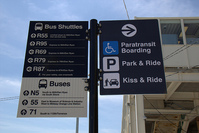Long-term closures: A solution to single-tracking?

Photo by cta web on Flickr.
Yesterday morning, the Chicago Transit Authority closed the southern end of the Red Line for 5 months of reconstruction. Should WMATA consider a similar approach? There are advantages, but also big dangers as well.
WMATA’s rebuilding problem, which it dubs Metro Forward, has been going on for over 2 years with no end in sight. Almost every weekend brings at least one major closure, like on the Green Line last weekend. When it’s over, Metro will be more reliable and passengers will experience fewer problems. But in the meantime, riders face service delays and other disruptions almost every weekend. Could a different approach work?
The CTA thinks so. Its Red Line South reconstruction project will close a portion of Chicago’s busiest line for 5 months. According to the CTA, the project would have taken 4 years to finish if it restricted the work to weekends only.
The agency chose to give both weekday commuters and weekend riders a lot of pain over a short time, rather than stretch it out over a long time. When finished, the reconstruction project will reduce travel times between 95th Street and Roosevelt by 20 minutes and will make the Red Line more reliable. By closing the entire line at once, riders will get to see those benefits sooner.
In the meantime, riders will have many alternatives to the Red Line, including several shuttle bus options to other L stations. Because of the increased volume of riders changing from shuttles to rail, CTA has also made temporary capacity improvements to the Garfield station on the nearby Green Line, including new staircases, faregates, and bus bays.
Additionally, the Red Line itself will be rerouted over part of the Green Line, and will operate 24 hours during the closure. To prepare for this, the CTA undertook an aggressive maintenance regimen on the Green Line track and structure, since trains will be running all the time, preventing any overnight maintenance.
However, there can be trade-offs. The Baltimore Light Rail was built as a single-track system with sidings where trains could pass one another. In 2004 and 2005, the Maryland Transit Administration closed each end of the line for about 6 months to reconstruct the line with two tracks. Before the project, train headways were limited to 17 minutes. Now, trains can run much more frequently.
During that time, MTA ran local and express shuttle buses to get riders around the closure, but ridership fell by 20% due to the inconvenience and took 3 years to recover, according to a source at MTA. When riders don’t have transit options for long periods of time, they make alternate arrangements, like moving or purchasing a car.
If WMATA were to close a line for a long time, the agency could help to mitigate the inconvenience to riders by working with local jurisdictions to set up temporary bus lanes, signal priority, and other transit improvements. Adding additional buses to parallel routes, routing buses to different terminals, and discounting fares are all approaches that could help keep riders on board during the work.
Metro Forward is a big undertaking, and even when it’s done, weekend work may still be necessary for future repairs. But for large projects, like Metro’s years-long Red Line rehab, closures might get the work done sooner. However, it would cause significant disruption and a potential drop in ridership.
